Whether you have decided to create a business site, personal site, blog or landing page, there is always the same question on your mind, “How to create a website?” Regardless of the type of website you want to create, there are some basics you need to know in order to understand how to create a website.
You will have to choose the tools to use i.e. the platform that will allow you to create the site, then you will have to deal with the structure, appearance and configuration of the site.
The goal of this article is to give an answer to the most common questions about how to create a website. Starting from how to choose the platform to use, through the choice of the domain, to how to structure the site so that it is SEO friendly.
If, on the other hand, you want to get some specific tips for a blog, check out the guide on how to create a blog.
Table of Contents
How to create a website: choosing the platform
In this section, we will take a look at some of the most used platforms. If you want to know how to create a website, you should know that there are mainly two ways to do it.
The first one is to use a site creator or a fully hosted platform. In this way, you have the software to create your site and the web space offered by a single provider. Examples of hosted solutions include Wix, WordPress.com, and Squarespace.
The second method, on the other hand, is to use a self-hosted platform or choose a CMS and choose a hosting that will provide you with the space and resources you need to create a website. Examples of this type are WordPress.org, Drupal or Joomla.
Keep in mind that in this article we will not be dwelling on platforms designed specifically for e-commerce. You can find an in-depth overview of platforms for online sales in our guide on how to create an e-commerce website.
To make this article more accessible and help you understand how to create a website we have divided the platforms into these two broad categories: hosted and self-hosted.
How to create a website with a hosted platform? There are many alternatives, but we have focused on three of the most widely used solutions.
Wix

Wix is a fully hosted website creator, which means that it provides you with a platform to create the site and a hosting service.
Wix gives you the chance to create a free site or choose one of the Premium packages available to enjoy other features. In this section, we’ll look at the features of the platform, but you might also be interested in taking a look at the Wix vs WordPress comparison.
How to create a website with
Wix: comparing free and premium plans
Let’s see an overview of what it offers and what are the differences between the free and premium plans.
Advertising on the Wix site
With the free plan Wix ads will be shown on your site, all premium packages, on the other hand, allow you to remove ads.
Domain
When you create a free site with Wix you are entitled to a free domain name:
username.wixsite.com/namesite
To link a custom domain you must purchase the Link Your Domain premium package. This package costs $4.5 per month and allows you to use a personal domain purchased from Wix or any other provider.
With the Combo, Unlimited and VIP premium packages, you are entitled to a voucher to have your domain free for one year, choosing from a few specific extensions (.com, .net, .org, .biz, .info, .co.uk, .club, .xyz, .space, .rocks and .pictures).
Space and bandwidth
Depending on the plan you have the following storage space and bandwidth specified below:
Free Plan: 500 MB of space and 500 MB of bandwidth
Link Domain Plan: 500 MB space and 1 GB bandwidth
Combo Plan: 3 GB of space and 2 GB of bandwidth
Unlimited Plan: 10 GB of space and unlimited bandwidth
VIP Plan: 35 GB of space and unlimited bandwidth.
Online payments and other features
If you want to create an e-commerce site with Wix, you’ll need to be able to accept online payments, a feature that is not available on regular premium plans. Wix offers dedicated packages for Business and e-commerce.
The Business Basic, Business Unlimited, and Business VIP plans all allow you to accept online payments. Depending on the plan you choose, you’ll have more storage space and you can take advantage of multi-channel selling, including dropshipping and marketplaces.
Costs
Now that we’ve compared the features of Wix’s premium and business plans, let’s take a look at the costs of the different packages.
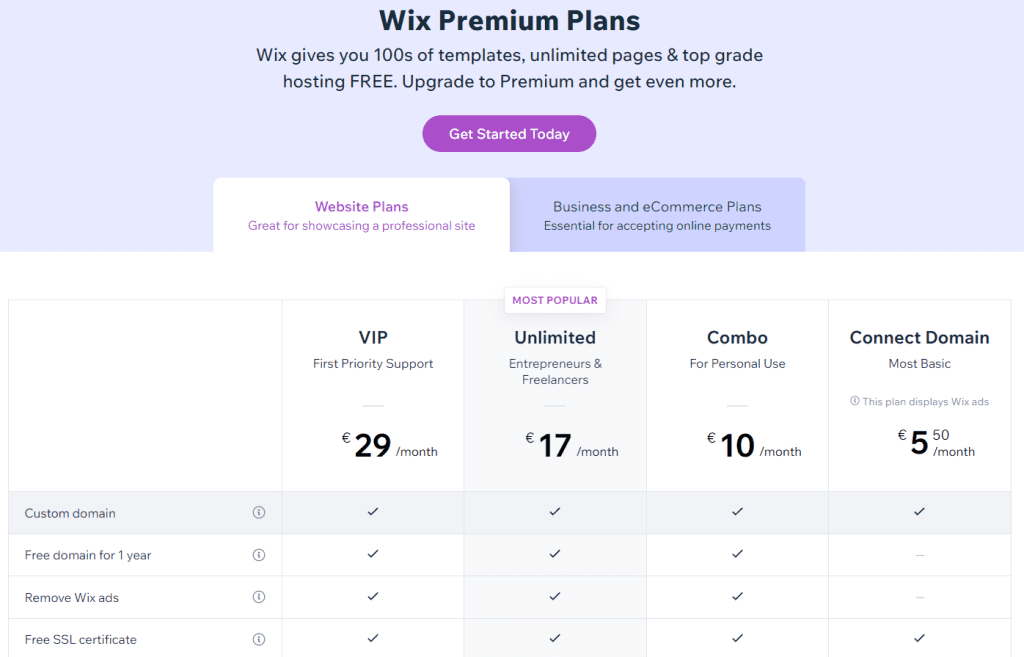
Premium Packages
- Domain Link Plan: 5,5€ per month
- Combo Plan: 10€ per month
- Unlimited Plan: 17€ per month
- VIP Plan: 29€ per month
Business Packages
- Basic Business Plan: 20€ per month
- Unlimited Business Plan: 30€ per month
- VIP Business Plan: €44 per month
How to create a website with Wix: platform features
Wix has two editors to help you create a website: Wix ADI and Wix Editor.
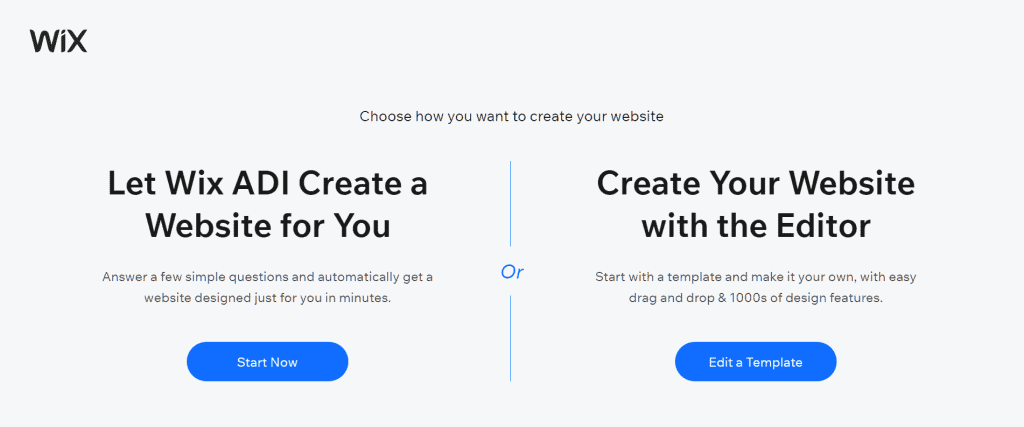
Wix ADI is a tool for creating a website in a simplified way. To start, you’ll be asked questions about the type of website you want to create (portfolio, personal blog, product landing page, and so on).
You will then need to select other features you would like on your site such as a mailing list subscription form, a chat system, a reservation system, or a forum. You can also import content from an existing website when creating your site.
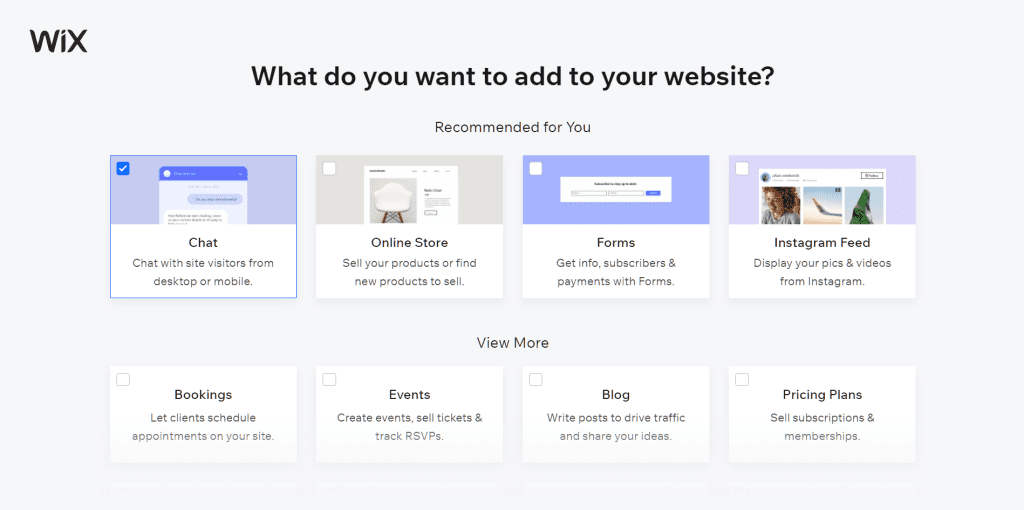
All the initial settings, including the choice of style and theme, can always be changed later.
One of the features of Wix Adi is the ability to automatically create certain pages on your site such as About Me or Contact Us.
Wix Editor allows you to create your website in a few simple steps. The first thing you’ll need to do is choose a template from the available categories (blog, online store, photography, and so on).
The template will be the foundation of your website and you’ll be able to add elements to the home page, create pages, and customize the background and theme. The Wix editor allows us to customize the site in a very intuitive way with the drag and drop system. This means that we simply find the element we want to add and drag and drop it onto the page.
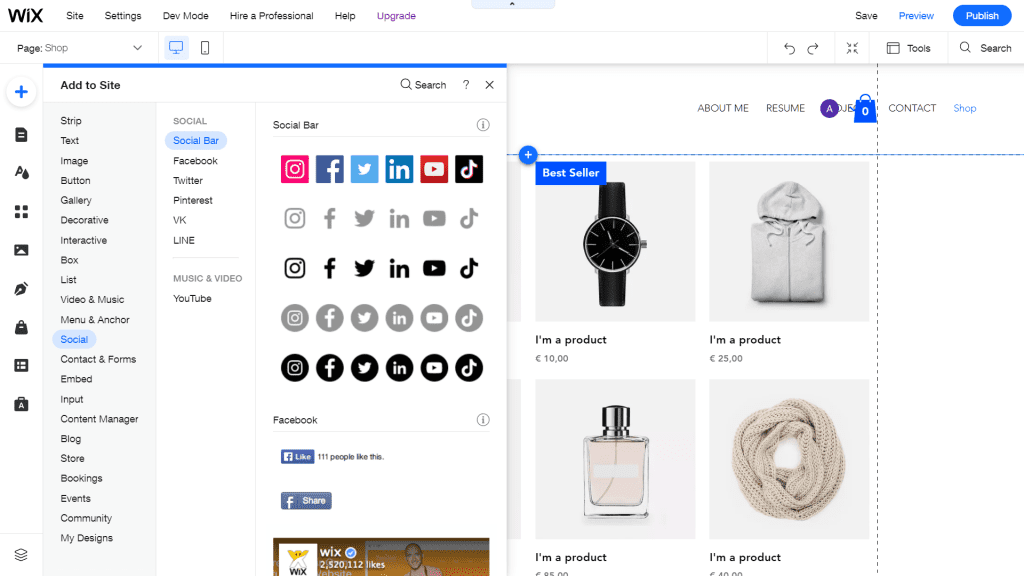
You can also expand the functions of your site by adding apps such as comment systems, forums, social media feeds, chat and so on.
We’ve seen how creating a website with Wix is easy and affordable for anyone. In addition to having an easy-to-use editor, Wix also allows you to create a customized site by answering simple questions.
While the biggest advantage of Wix is that it allows anyone to create a website, the platform is not without its flaws. In addition to the limitations of the free plan, I outlined earlier, one of Wix’s main drawbacks is portability.
If you create a site with Wix and decide to switch platforms, it’s important to know right now that you won’t be able to easily transfer all of your content. If you want to learn more check out our guide on how to transfer your site from Wix to WordPress.
WordPress.com

WordPress.com, which is owned by the company Automattic, is a service that allows you to use WordPress and also have a full hosting service with support available. When we talk about WordPress, therefore, we have to make a distinction between WordPress.org and WordPress.com.
To put it simply, WordPress.org refers to a free and open-source CMS that you can download and use on a server. You then need to have a hosting space and purchase an dominio internet, as we will see later in this guide.
WordPress.com’s service, on the other hand, is comparable to that offered by other website creators like we just saw for Wix.
How to create a website with WordPress.com: the available plans
With WordPress.com you can create a website for free with the free plan or choose the plan that best suits your needs. Let’s see the differences between the available plans.
WordPress advertising on the site and monetization
If you choose the free WordPress.com plan, advertisements will be shown on your site that you cannot control and cannot turn off.
To remove WordPress.com ads on your site you will need to subscribe to a paid plan among Personal, Premium, Business and eCommerce options.
With Premium and higher plans, you can also enable ads and earn money by joining the WordAds program.
Domain
With the free plan, your site is hosted on a WordPress subdomain, the address of your site will then look like this:
sitename.wordpress.com
In order to use a custom domain name and make your site look professional, you need to choose a paid plan. All plans (Personal, Premium, Business and eCommerce) allow you to set the domain you want as your primary address.
You can register a domain directly with WordPress.com, with another registrar, or link to a domain you’ve already registered.
If you subscribe to a premium plan for one year or two-year subscription you can register a new domain and the first year will be free.
Storage Space
Each plan gives you a certain amount of storage space for your site’s files:
- Free Plan: 3 GB of space
- Personal Plan: 6 GB of space
- Premium Plan: 13 GB of space
- Business Plan: 200 GB of space
- e-commerce Plan: 200 GB of space.
Recently the thresholds have changed and only the free plan and a paid plan are available on the plans page. The previous plans, mentioned above, no longer seem to be available.
We therefore find:
- Starter Plan: 6GB of space.
- Pro Plan: 50GB of space.
Online payments
Choosing a plan is important if you want to understand how to create a website to sell with WordPress.com. With all plans except the free one, you can use the Payments feature that allows you to accept credit card payments using Stripe’s service. To receive PayPal payments, however, you must have a Premium, Business or eCommerce plan.
Costs
Now that we’ve gone over the main features of the plans offered by WordPress.com, we just have to take a look at the prices.
By subscribing to a monthly subscription the costs will be:
- Personal Plan: 7€ per month
- Premium Plan: 14€ per month
- Business Plan: 33€ per month
- e-commerce Plan: 59€ per month.
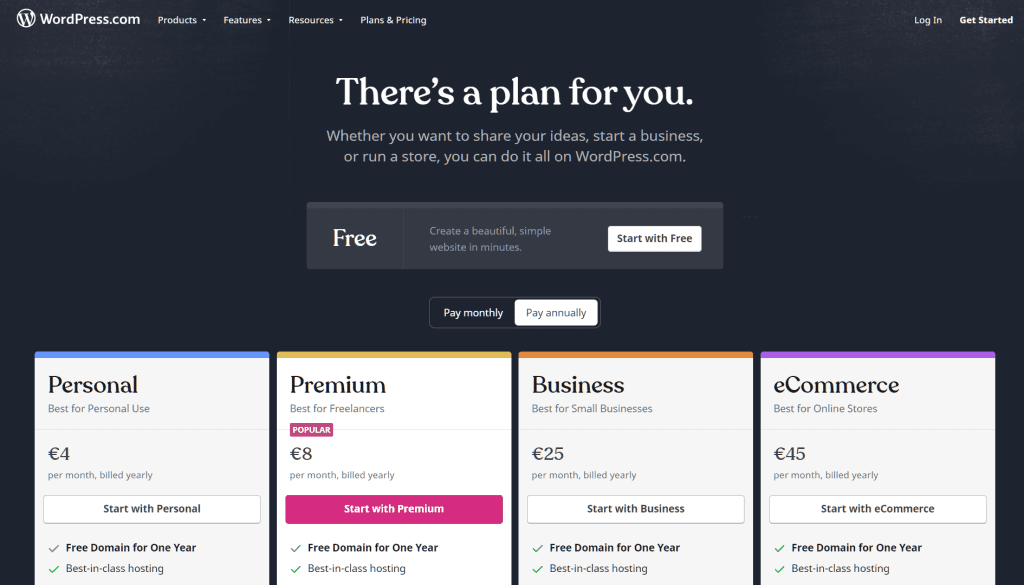
With an annual subscription you get cheaper costs:
- Personal Plan: 4€ per month
- Premium Plan: 8€ per month
- Business Plan: 25€ per month
- e-commerce Plan: 45€ per month.
Remember that the annual subscription offers you extended functions compared to the monthly one. As we have seen before with the annual plans you can register a new domain and you don’t have to pay the domain fee for the first year.
Moreover, annual plans guarantee you chat support (Premium, Business and e-commerce plans) and priority chat support (Business and eCommerce plans).
Like the thresholds, the prices of the plans have also been updated.
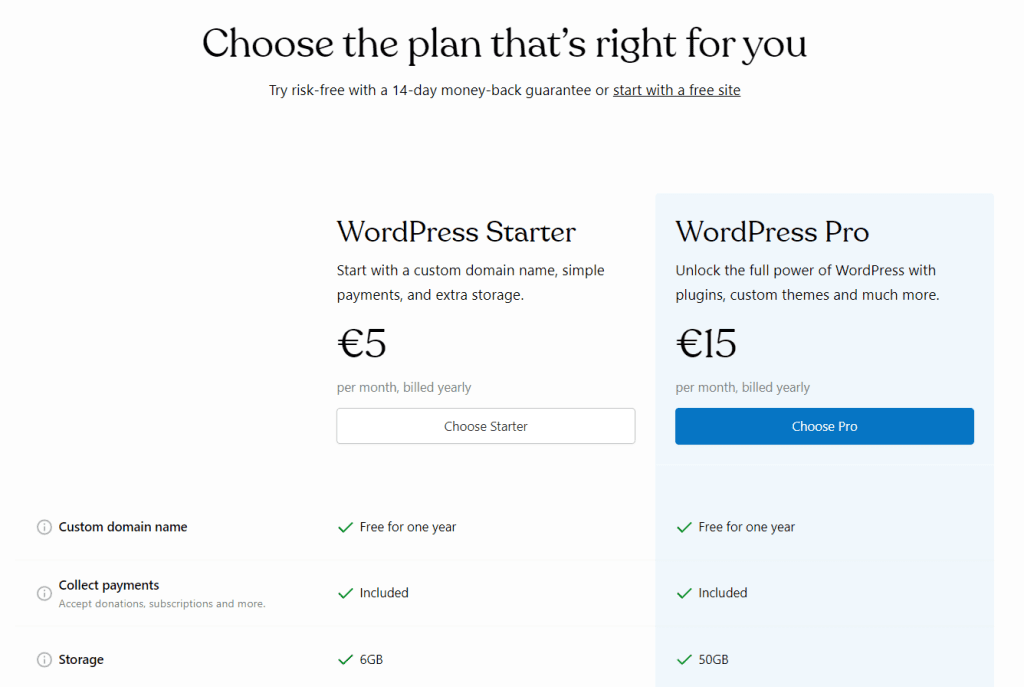
Currently (May 2022) available plan prices are as follows:
- Starter Plan: 5€ per month with annual subscription.
- Pro Plan: 15€ per month with annual subscription.
How to create a website with WordPress.com: features of the platform
Basically, WordPress.com has built-in plugins, including Akismet, social integration, advanced galleries and other widgets.
However, in order to install the plugins you prefer, you’ll need to have a Business or e-commerce plan. With these plans, you can install plugin WordPress from the WordPress.org directory or premium plugins purchased elsewhere.
With the ability to install other plugins you can extend the functionality of your site, for example, create an e-commerce site using WooCommerce, or create a multilingual WordPress site with Polylang.
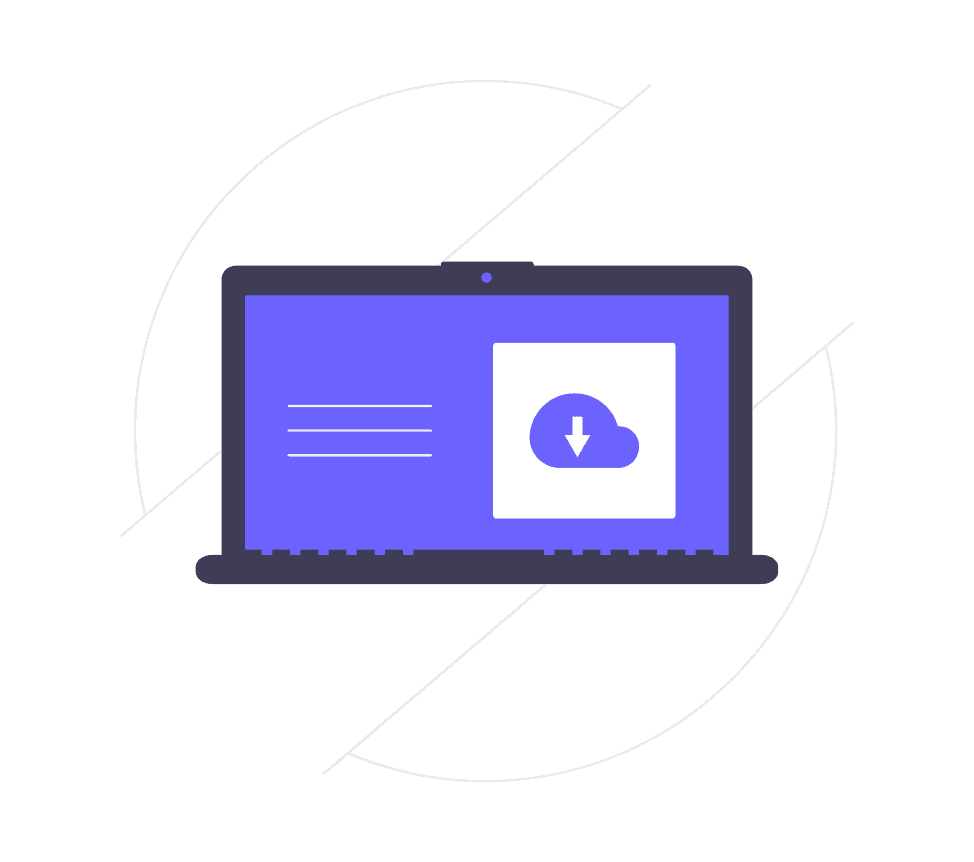
Not all plugins are supported, the plugins you cannot install include for example backup plugins like Duplicator.
Make sure the plugin you want to install is supported by checking the list of unsupported plugins on WordPress.com.
The same thing applies to WordPress themes, you can use custom themes, such as third-party themes purchased on marketplaces like Themeforest only if you have a Business or eCommerce plan.
Instead, theme customization and the ability to add custom CSS is a feature available for Premium plans and upwards.
The backup and restore feature, as well as SFTP access and database management with phpMyAdmin is also reserved for sites with an active e-commerce or Business plan only.
Squarespace

Squarespace is a website builder that includes a hosting service. Unlike Wix and WordPress.com, Squarespace does not provide a free plan, only a 14-day free trial.
How to create a website with Squarespace: the available plans
Squarespace provides us with four plans to choose from: Personal, Business, Basic Commerce and Advanced Commerce. Let’s see the features of each one.
Domain
All plans allow you to register a new domain and not have to pay the domain cost for the first year. However, the free domain for one year applies only to certain extensions, i.e. all TLDs that cost 18€.
If you choose to register a domain with a higher-priced TLD you will not be able to take advantage of the free domain for the first year.
Space and Bandwidth
Plans have no space or bandwidth limits.
Online payments and other features
With the Business and Commerce plans you get access to Commerce features that allow you to create an online store.
You have no limit on the number of products you can sell and you can accept payments by these methods: Stripe, PayPal and Square. The Business plans have a 3% commission on sales, in the Commerce plans (basic and advanced) there is no commission on sales.

With Commerce plans, you can also accept offline payments and create a secure payment page on your domain.
Other features reserved for Commerce plans are:
- selling products on Instagram (basic Commerce)
- selling subscriptions (Advanced Commerce)
- Recovery of abandoned shopping carts (Advanced Commerce)
- automatic calculation of shipping costs (Advanced Commerce)
- addition of labels for products in limited supply (basic Commerce).
Costs
Squarespace’s plan costs vary depending on the type of subscription.
Monthly payment plans have these rates:
- Personal Plan: 15€ per month
- Business Plan: 24€ per month
- Basic Commerce Plan: 28€ per month
- Advanced Commerce Plan: 42€ per month
Subscribing to an annual plan
- Personal Plan: 11€ per month
- Business Plan: 17€/month
- Basic Commerce Plan: 24€ per month
- Advanced Commerce Plan: 36€ per month
Does Squarespace seem too expensive? Check out these Squarespace alternatives.
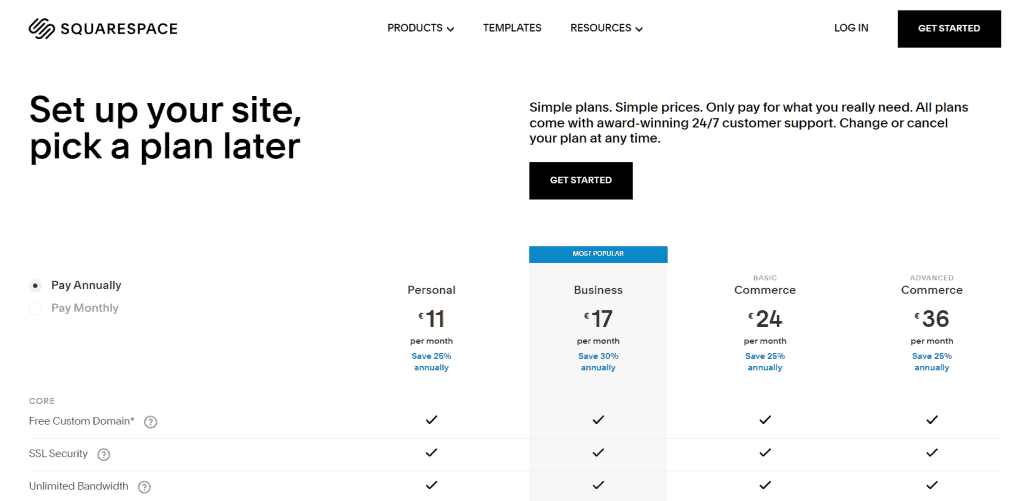
How to create a website with Squarespace: features of the platform
With Squarespace, you can start setting up a site before choosing the plan that best suits your project.
You can start to get an idea of the site by answering some simple questions about the theme covered by the site and your objectives (sales, promotion of an event, etc.). Based on your answers Squarespace will present you with a series of templates that might interest you.
Starting from the Business plan and above you can customize the basic templates with CSS and Javascript. In addition, with the Business or Commerce plan, you will also have available premium blocks. Thanks to them you can extend the functionality of the site, for example by adding booking or ordering systems, adding an ad bar on the site and so on.
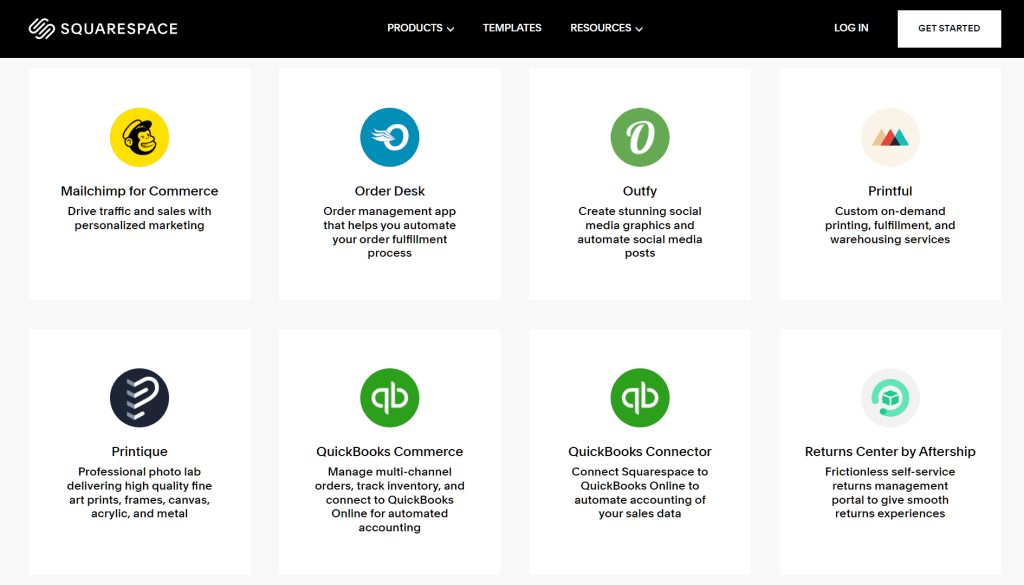
Other functions are available using extensions (the equivalent of plugins for WordPress or apps for Wix).
How to create a website: self-hosted platforms
To create a website with a self-hosted platform you need hosting and a domain name for your site. After that, it’s time to choose the CMS that’s right for you.
Let’s first look at how to create a website from the basics, starting with choosing a hosting and domain name and then moving on to examine the different CMSs.
Choosing a hosting
Choosing a hosting is one of the most important steps for the success of your project. The choice of the plan depends on the site you want to create, but there are other factors you should consider in any case.
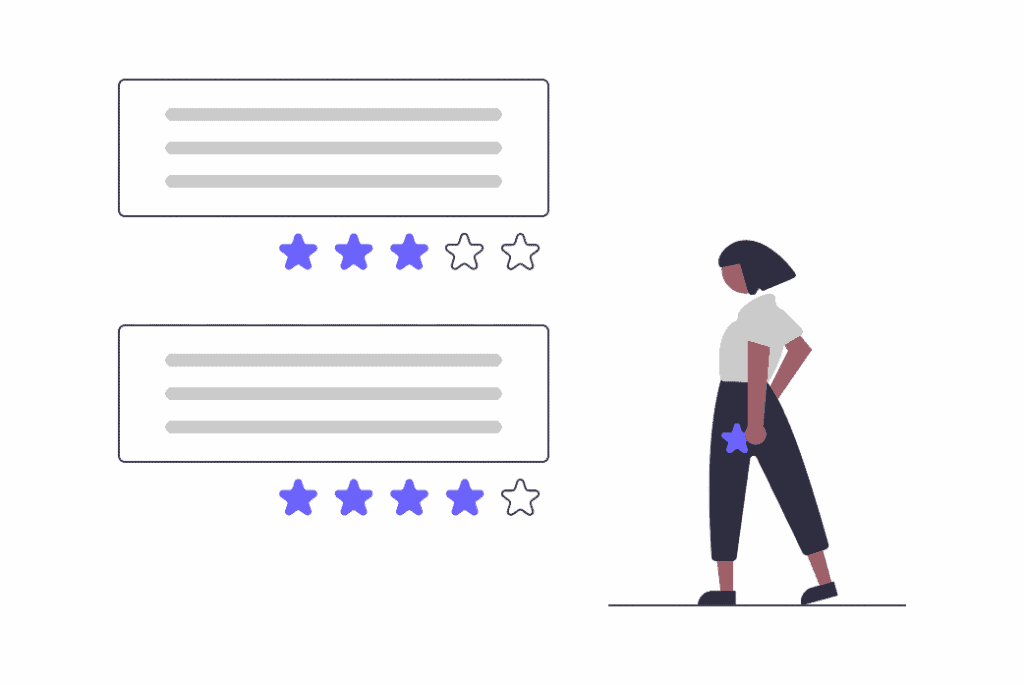
How to choose reliable hosting? Here’s what you should keep in mind:
- Aim for companies that are structured (exclude one-man companies) and have been active in the market for years
- Check reviews
- Test the support
- Check if you can try the service for free before deciding.
You should also evaluate the assurances offered by the provider such as guaranteed uptime.
Moreover, you should also take into consideration the provider’s policies, for example you should know that not all providers allow you to host adult content on their servers.
Whichever CMS you have chosen, you can go two ways:
- Choose a CMS hosting such as WordPress hosting, Joomla hosting or Drupal hosting and start setting up your site right away.
- Choose a shared hosting, semi-dedicated hosting or a dedicated solution such as VPS cloud hosting and dedicated server and install the CMS. With SupportHost the installation is done in a few clicks thanks to Softaculous.
Choosing a domain
In addition to choosing the hosting, you have to decide what will be the name of your domain and make sure that it is among the free domains or has not already been registered by someone else.
You can choose the domain name to represent your business and make it correspond to your brand name. Or in the case of a portfolio, a personal blog or a professional site you can choose as a domain name the combination of your name and your surname.
There is another way to choose a domain name that reflects the topic of your site.
Once you have chosen the domain name and checked that it is available, you just have to register it.
Keep in mind that the domain can be included in the hosting, usually for the first year the domain is free. With SupportHost the domain is always free even at renewal: with all plans, the cost of the domain is always included in the price.
Choosing a CMS
After choosing the hosting and domain, in order to understand how to create a website you need to choose the platform. Let’s see, how to choose the CMS by considering the three most widely used systems: WordPress, Joomla and Drupal.
WordPress

WordPress is used in 42,6 % of websites and has a market share of over 65% among CMSs. In short, WordPress is, therefore, the most widely used CMS of all, it is free and open-source, driven by an active community that keeps the platform up-to-date and secure.
Let’s take a look at some of the main features that make WordPress the most used platform.
User-friendly: not only is it easy to learn how to use it but there are tutorials, guides and videos that help you through all the operations. In addition to official resources such as the forum and Codex. All these resources will help you understand how to create a website with WordPress. Want to get started right away? Check out our WordPress tutorial with step-by-step explanations.
Versatility: with WordPress, you can create any kind of website: from a blog or a personal site, up to magazines, e-commerce and forums.
Functionality and customization: with plugins (we are talking about more than 58 thousand free plugins) you can extend the functions, optimize the site, create contact forms, calendar/booking systems and so on. With themes (free and premium) you can customize the look of your site, just think that there are 8,776 free themes only in the official directory of WordPress.org.
Complete management options: with WordPress you can take care of every aspect of your site. You can manage the users who have access to the site and allow others to collaborate in managing and creating content. You can install themes and plugins, easily create content with Gutenberg, the block editor, automate tasks (including updates) with WP-CLI and so on. If the technical management of the site puts you off, you can lean on a managed WordPress service.
Joomla

Joomla is used in 1.9% of websites and 2.9% of sites that use a CMS. This is a free and open-source CMS based on a MySQL database.
The functionality can be expanded with extensions that you can find in the official directory. Among the noteworthy extensions is VirtueMart used to add useful functions to create an e-commerce.
The appearance of the site can be customized by modifying the available templates. Many of the templates, in fact, allow you to change colors, fonts, functionality and layout through a graphical interface and therefore without having to have knowledge of code.
To become familiar with the functions of the CMS and understand how to create a website with Joomla, you can refer to the documentation, the forum and the official tutorials.
The native multilingual function and in-depth user management system are among the features of Joomla.
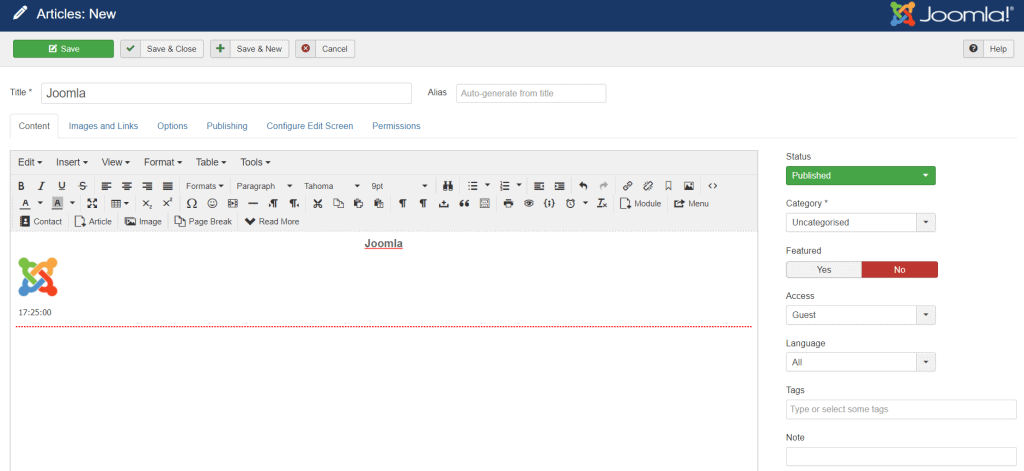
The creation of articles is similar to the classic WordPress editor with the ability to insert images with drag & drop, schedule the publication of articles and keep the changes made to the posts so you can recover previous versions.
Drupal

From CMS usage statistics, Drupal appears to be used in 1.4% of websites and 2.2% of sites using CMS. Like the other two CMSs we have seen, Drupal is also free and open source.
Drupal is ideal for creating complex sites with a large amount of content. Its functions can be extended with thousands of available modules that allow you to create contact forms, integrate Google Analytics reports, create manual redirects and so on.
To customize the design of the site you can use the themes, some even free, that you can find directly on the official website.
How to create a website: the structure of the site
If you want to learn how to create a website, one of the first elements to consider is the structure that your site will have. The architecture or structure of a site represents the way the pages are organized and connected to each other.
An optimal structure helps users and search engines navigate through the site and reach all the content.

Let’s not forget, in fact, that the structure of the site is not only important for the user experience, but it is also crucial for SEO.
To understand why we need to open a brief discussion on how website indexing works.
Search engines use crawlers, which is software that can automatically navigate web pages and create a real index. Until the page is included in this index, i.e. it is not indexed, it cannot appear in the search results.
The fact that a page is indexed, therefore, does not automatically guarantee that it will appear in the SERPs. But the opposite is true: if the page has not been indexed, it is as if it does not exist for the search engine, and therefore, it can never appear in the search results.
The structure of the site can make it difficult for crawlers to crawl and is, therefore, one of the critical points that can compromise the indexing of content.
The main problems are:
- pages that are many clicks away from the home page (more than 5, 6 clicks)
- pages that are not linked to any other page of the site (also called orphan pages) and are not included in the sitemap.
How to create the structure of a website
The structure will be the skeleton of your website, so to understand how to create a website you must also know how to create its structure.
The structure will be more or less complex depending on the size of your site, but there are some rules you can start from in any case.
The site should have a flat structure. What does this mean? A flat structure means that the pages are 3 or 4 clicks away from the homepage. The opposite situation is given by deep structures where pages are 5 to 10 clicks (or even more) away from the home page.
Remember to limit the depth of the pages of your site by identifying the sections and pages you need and creating a mind map. You can do this simply on paper or use an online tool like MindMeister or Miro.
Taking care of the site’s appearance
After you’ve chosen and installed your CMS or started creating a site with a site builder like Wix, it’s time to shape your site. You can customize your site from an existing theme or template or hire a web designer to create a custom theme for your site.

With WordPress in addition to the choice of the theme, you can also design the entire site by managing the layout of the elements without having to intervene on the code. In order to do this, page builders have been designed which allow you to see the changes made to the site in real-time. Some examples are Elementor, Divi or WP Page Builder.
Add functionality to the site
Depending on the site you are creating you may need elements and features that are not already integrated. You can use plugins, apps, modules or extensions to address these needs, depending on the ecosystem you’re using to create your website.
Some features you might need are spam filters, social sharing plugins, contact forums, and SEO tools.
Legal aspects and mandatory data
Don’t forget that there are also legal aspects to consider.
If you have a VAT number (company, private company or individual) you have to show the VAT number on the home page of the site. Among the mandatory data for companies there are also:
- company name or name and surname
- address of the registered office
- reference to the registered business office and REA.
It is also important to enter the terms and conditions of the site. For SPA and SRL you will also have to enter additional information such as capital stock and company name.

You’ll also need to adapt the site to the GDPR by creating a notice informing users of the use of cookies, a cookie policy page, and a privacy policy page. Don’t forget that contact forms must also comply with the regulation. If you’re creating a site with WordPress check out our article on Contact Form 7 and how to adapt your contact form to GDPR.
Conclusion
To understand how to create a website you need to follow some basic steps whatever type of site you want to create. The first thing to do will be to choose the platform to use among the many solutions available.
As we have seen website creators are the ideal solution for those who want to understand how to create a website from scratch. However, in some cases, there are limitations that make these solutions not suitable for any project.
If you want to create a more complex site or have the ability to manage every aspect of your site you should go for a self-hosted platform and choose a hosting service.
Having overcome the hurdle of choosing a platform, there is still a long way to go. We have seen that in order to understand how to create a website you need to focus on the structure, the graphical aspect, the functionality of the site and last but not least, the legal aspects.
Now it’s your turn to create your website! Have you already decided on which platform to use? Let me know in the comments below.



Leave a Reply